20,000 Tortoises in Madagascar are waiting to return to the wild.
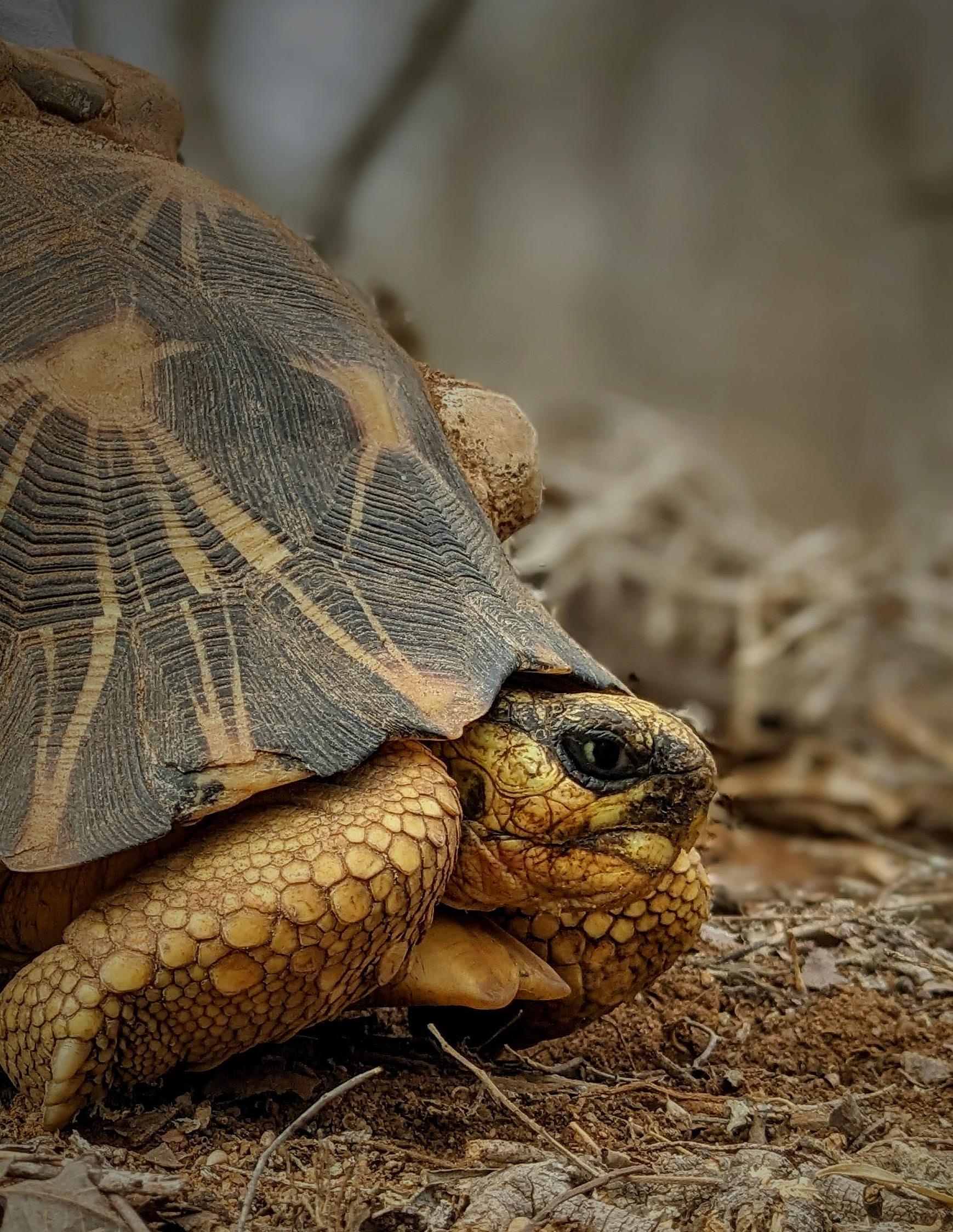
Help them complete their journey home.
The response to the massive confiscation of 10,000 Radiated Tortoises in 2018 was Turtle Survival Alliance’s finest hour. The zoo, veterinary, and conservation community came together as never before. But six years later, we are still left caring for these tortoises at a considerable expense. We are now calling on that same community to rally again and help us get these tortoises back into protected habitat.”
– RICK HUDSON, PRESIDENT EMERITUS
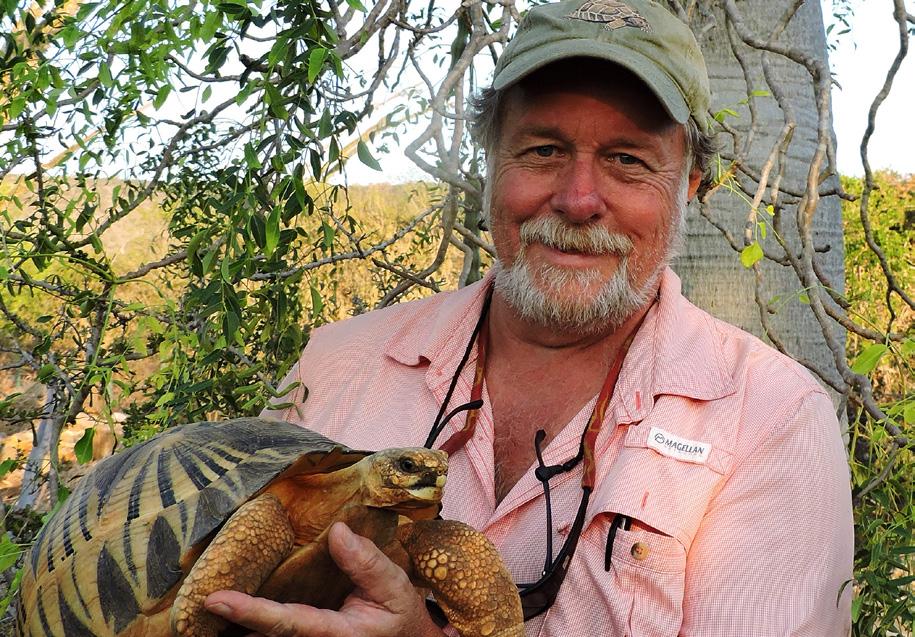
The Need for Intervention
The world’s fourth largest island, Madagascar has long been recognized as an important hotspot for conservation and is ranked as one of the top megadiversity countries. It is home to an astounding number of endemic species – found nowhere else on Earth. Protecting the plants and animals of this island is one of the most pressing conservation priorities today, and there is no time to lose.
The four tortoise species found on the island have populations in rapid decline as a result of habitat loss and poaching. They are ranked Critically Endangered by the IUCN Red List. In keeping with our mission, Turtle Survival Alliance (the Alliance) is working to save them all from extinction and restore wild populations.


RADIATED TORTOISE (Astrochelys radiata)
The beautiful Radiated Tortoise was once one of the most abundant tortoises in the world, but has undergone a catastrophic decline due to poaching. Adults are harvested for bushmeat consumption and juveniles are collected for the illegal pet trade, leaving wild populations depleted or locally extinct.
PLOUGHSHARE TORTOISE
(Astrochelys yniphora)
A close relative to the Radiated Tortoise, the Ploughshare Tortoise has long been regarded as one of the most endangered tortoises in the world. Despite intensive conservation actions over the past 38 years, Ploughshares are now functionally extinct in the wild, sadly the victim of the illegal pet trade.

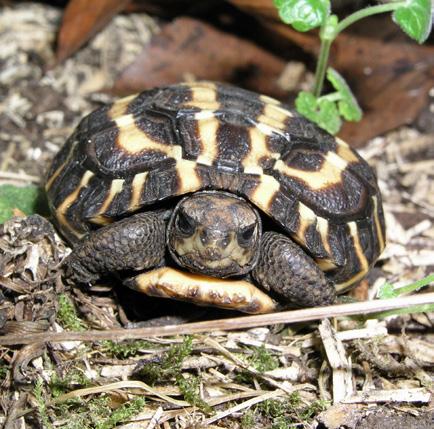
SPIDER TORTOISE (Pyxis arachnoides)
The Spider Tortoise inhabits open coastal sandy areas, where they are highly vulnerable to poaching pressures and are rapidly disappearing due to collection for international pet markets.
FLAT-TAILED DWARF TORTOISE (Pyxis planicauda)
The Flat-tailed Dwarf Tortoise is restricted to small patches of dry forest habitat in western Madagascar that are being lost at an alarming rate due to burning for agriculture.
IUCN 2024. The IUCN Red List of Threatened Species. Version 2023-1.
Saving Madagascar’s Tortoises from the Brink of Extinction
Turtle Survival Alliance is committed to ensuring that wild populations of Madagascar’s tortoises survive into the future.
Our team of dedicated conservationists – in collaboration with local communities and biologists – have developed a comprehensive 5-year plan for the reintroduction of 20,000 Radiated Tortoises into their southern range on the island.

Each icon represents a general location of Turtle Survival AllianceMadagascar’s long-term care facilities, triage facilities, breeding centers, community forests, and national headquarters. The green areas represent the collective ranges of the tortoise species we work with.
Since 2012, we have tackled the Radiated Tortoise poaching crisis with our Malagasy colleagues through community awareness, training, and improved enforcement capacity. Our joint efforts realized tremendous success when we were able to confiscate a vast number of tortoises from the illegal wildlife trade.
Finding housing and caring for thousands of tortoises of various ages and in varying states of health is no small task. Fortunately, the Alliance was able to respond swiftly and answered the need by building five small rescue centers for immediate triage and holding. Two large comprehensive facilities were also completed– the Tortoise Conservation Center and the Lavavolo Tortoise Center – one in each of the two regions where Radiated Tortoises are still found. To provide some context of the enormity of this type of animal
husbandry, the tortoises housed at these two centers consume 3,000 kg (6,614 lbs) of food per week and are operated by more than 50 local staff.
The demand is growing, as are the pressures on us and our local partners to adapt our approaches for the conservation of these tortoise species facing the greatest risks. In 2018, poaching reached a dramatic peak, beginning with a record-breaking seizure of 10,000 sick and dying Radiated Tortoises in one house, followed by a second seizure of 7,000 tortoises. This placed about 15,000 new tortoises under the Alliance’s care in Madagascar and changed everything for our program, shifting us into a rescue and rehabilitation mode of operation. By 2019, there were 26,000 tortoises under our care and protection. This large captive population has placed a great strain on our financial and human resources and cannot be sustained long term.
Ultimately, the future of tortoises in Madagascar will depend on securing well-monitored protected areas with supportive local communities.”
– MARC DUPUIS-DESORMEAUX, PRESIDENT AND CEO
With the knowledge that rewilding these animals would take a long, cooperative, concerted effort, we began transitioning the Radiated Tortoises for their journey home, back into the wild. To implement this safely, we’ve designed the Confiscation to Reintroduction Strategy and have released 3,000 individuals thus far, with 4,000 more planned for reintroduction later this year.
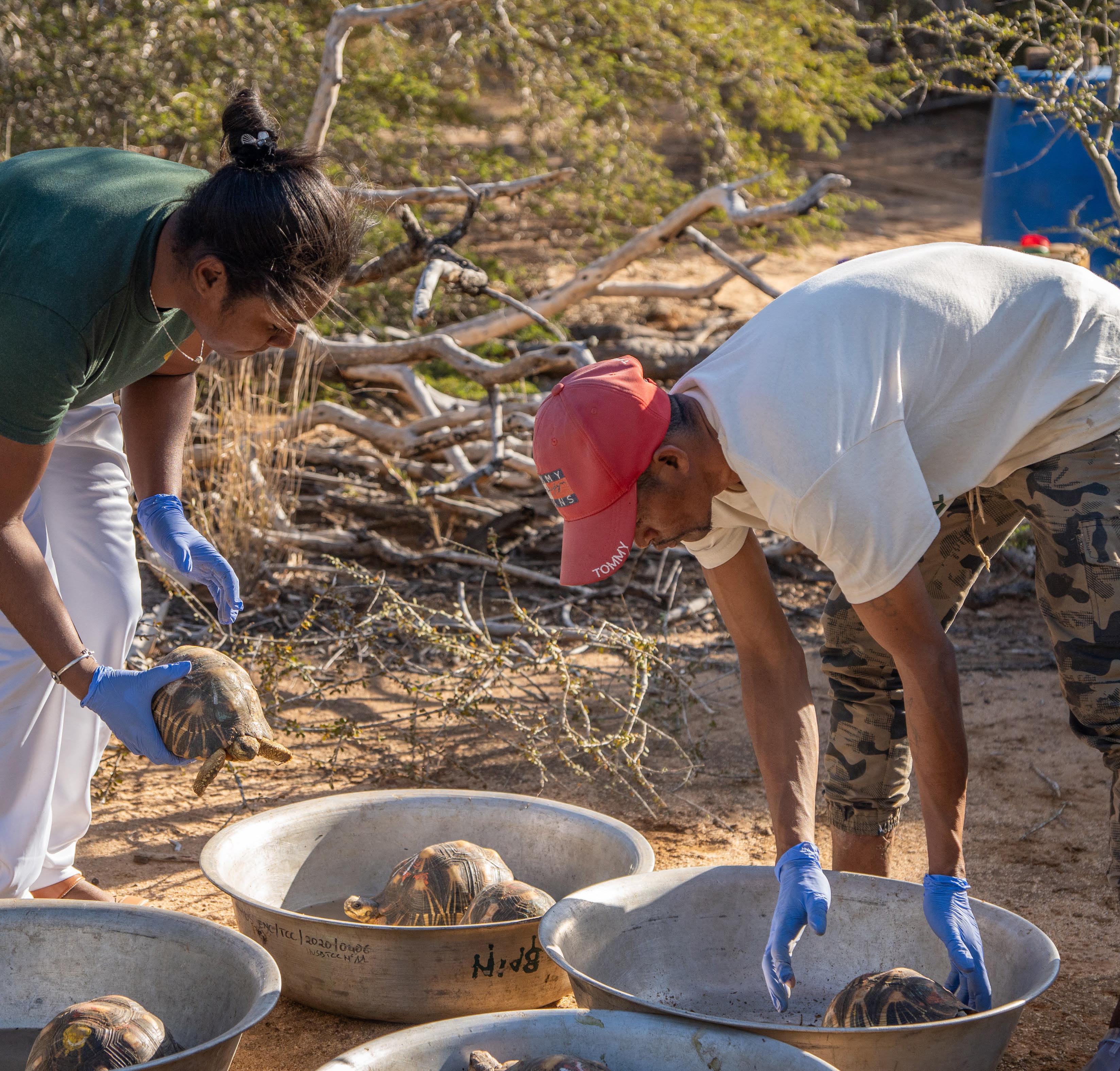 Photo: Radiated Tortoises are released into an expansive soft-release pen set into the habitat of a recipient site. Photo by Brett Bartek.
Photo: Radiated Tortoises are released into an expansive soft-release pen set into the habitat of a recipient site. Photo by Brett Bartek.
Transition from rescue to restoring tortoises on the landscape
Working in cooperation with law enforcement, Turtle Survival Alliance officials provide evidence of poaching activity and then oversee the seizure of illegal tortoises. Thanks to a grant from U.S. Fish & Wildlife Service, our enforcement team is growing and working hand-in-hand with the local law enforcement to disrupt tortoise poaching networks.
The restraint and movement of poached tortoises can be cruel and result in tortoises that are highly stressed, injured, or ill when we receive them. Our staff and partners stabilize tortoises in the field and then move them to our nearest rescue center for triage and emergency treatment.
Once the tortoises are stable, they are moved into one of our two long-term, spacious conservation centers where they will receive expert care and ongoing veterinary evaluation. The tortoises are maintained with a high level of care so that, when ready for release, they will have the best chance of thriving in the wild.
The sites selected for release must satisfy a number of criteria including obtaining the “buy-in” from local communities. This can take more than a year and involves establishing community-protected forests and continuing to engage the villagers to ensure long-term support.
Following thorough veterinary health assessments, tortoises are transported to the release site and placed into spacious fenced enclosures in natural habitat for a 6-month “soft release” period. At the end of this period the fences are removed, and tortoises are liberated, with a subset being intensely tracked for movements and survival.
Turtle Survival Alliance is making substantial progress in securing well-monitored protected areas, with supportive local communities nearby, both at the community and national levels.
CONFISCATION TO REINTRODUCTION STRATEGY:
PROTECTED AREAS
CONFISCATION
LONG-TERM CARE
RESCUE
REINTRODUCTION SITE SELECTION 1 2 3 4 5 6
REINTRODUCTION
Community Engagement
A large part of any conservation project is understanding local communities and working together for mutual benefit.
When human populations are faced with high levels of poverty, food insecurity, and tremendous uncertainty about their own future, it can be challenging to demonstrate to community members that protecting wildlife, can be of benefit to the community. The Alliance has worked hard with local communities to demonstrate that they have a role to play and that, likewise, tortoises can benefit them and the environment. We first demonstrated one very tangible benefit in 2012, when we built a school in a village that held a tradition of protection towards wild tortoises. Since then we have
built two more schools and a water cistern to improve our relationship with the communities. In the coming years, we plan to expand our community engagement activities as a means of creating self-sustaining tortoise populations that benefit from local protection.
Participating in conservation also has other tangible benefits and can increase community capacity. Once release sites are identified, in preparation for receiving tortoises, nearby communities are evaluated for their willingness to monitor and protect a reintroduced population of tortoises. Community members are trained to be forest wardens to monitor tortoises, and trained in forest management techniques, creating jobs and more sustainable futures for all.
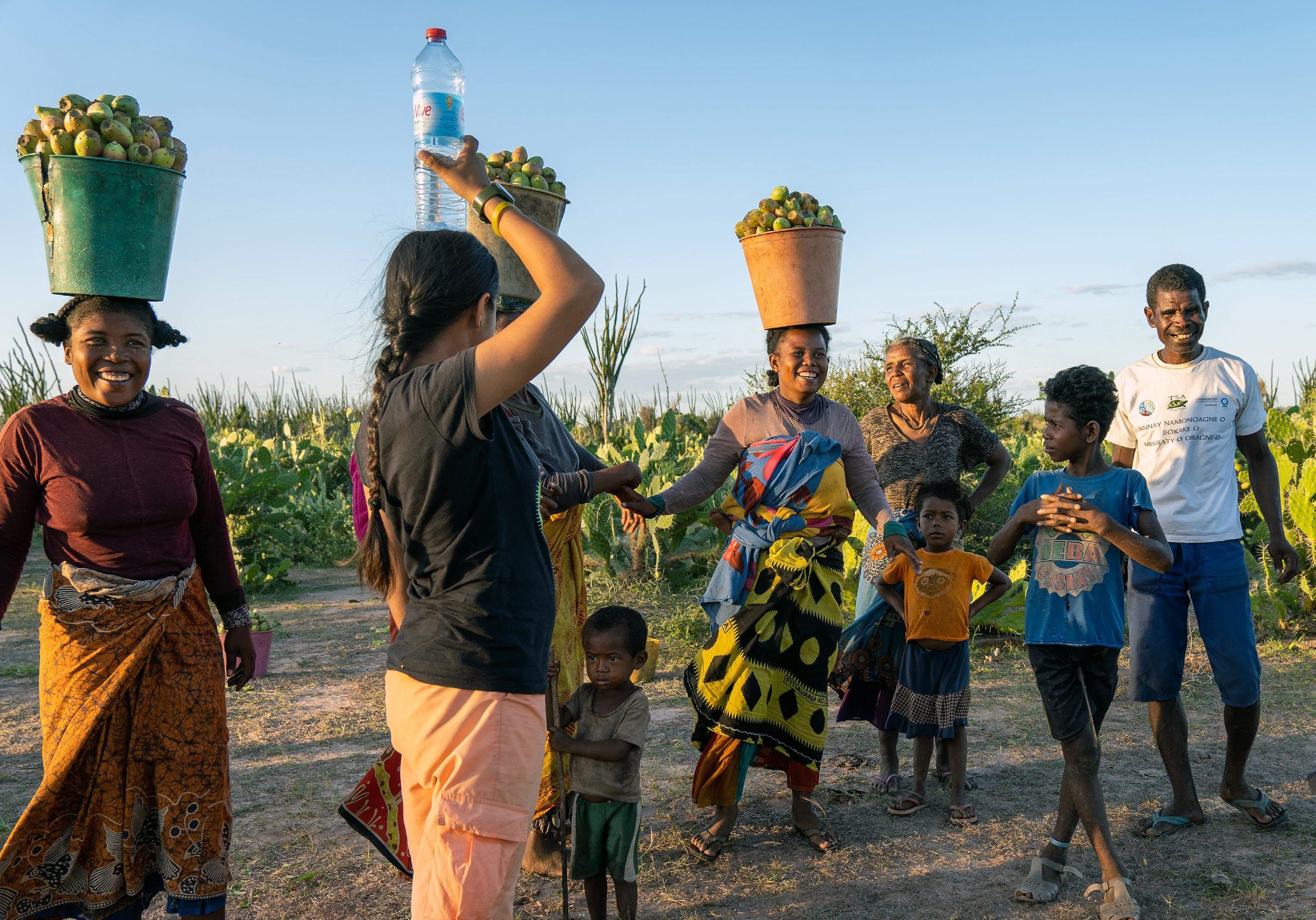 Local women hired to collect cactus fruits to use as tortoise food at the Tortoise Conservation Center. Photo by Lance Paden.
Local women hired to collect cactus fruits to use as tortoise food at the Tortoise Conservation Center. Photo by Lance Paden.
The Next Five Years
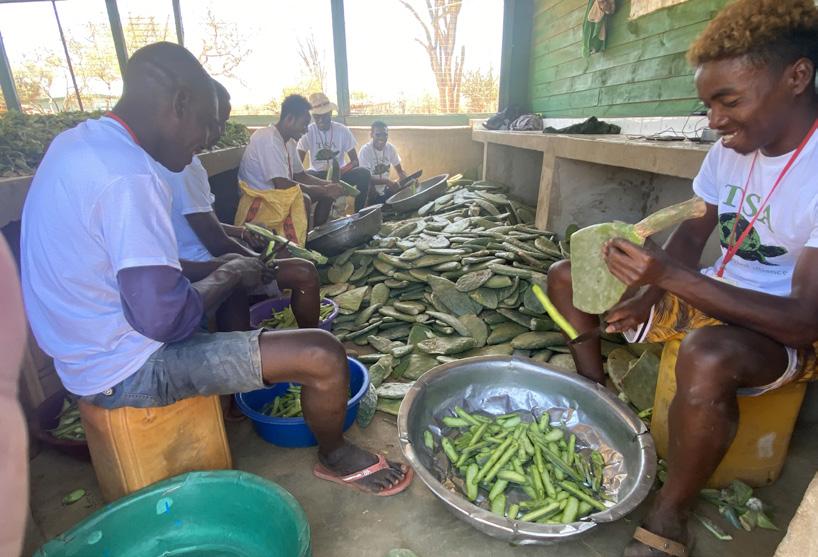
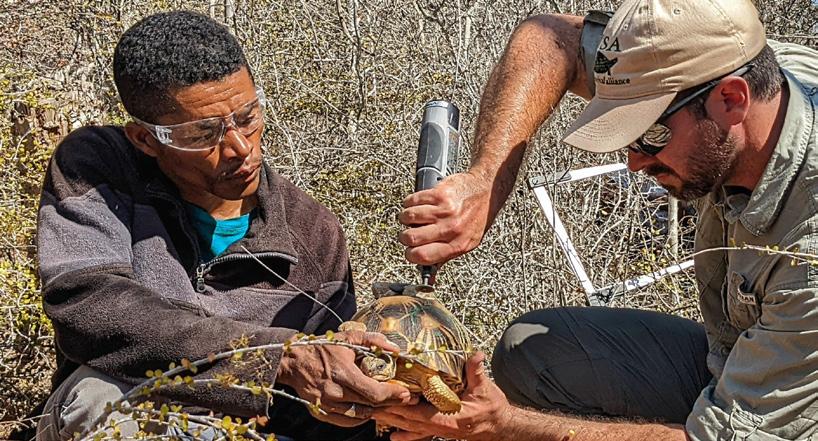
The next five years will be critically important for reintroducing the Radiated Tortoises back into the wild. As outlined, it has been a tremendous task, and much remains to be done. An estimated $2.5 million is needed to fund the tortoises’ journey back home. The cost of returning them to their natural habitat over the next five years includes implementing anti-poaching measures, employing community guardians, creating alternative livelihoods to reduce the need for poaching, and establishing monitoring systems. These efforts are essential to ensure the safety and well-being of the tortoises as they reintegrate into their ecosystems.
Turtle Survival Alliance stands between the extinction and survival of the Radiated Tortoise in the wild.”
– RUSSELL MITTERMEIER, PH.D., BOARD MEMBER
Budget Projections YEAR 1 $750,000 $600,000 $450,000 $400,000 $300,000 TOTAL $2,500,000 YEAR 2 YEAR 3 YEAR 4 YEAR 5 Annual Budget - Year 1 Item Amount Facilities Management $325,000 Monitoring and Research $100,000 Community Engagement $150,000 Veterinary Care and Supplies $50,000 Anti-Poaching Initiatives $50,000 Site Identification and Habitat Restoration $50,000 Animal Transportation $25,000 TOTAL $750,000 While this is a substantial amount, the urgency of the situation demands immediate action.
43% 13% 20% 7% 7% 7% 3% Year 1
Top: locals prepare cactus to feed tortoises. Per week, 3,000 kg (6,614 lbs) of food is consumed. Bottom: researchers remove a GPS logger from a reintroduced tortoise. Photos by Tantely Rasoariamanana.
Madagascar By the Numbers
3 Tortoise care facilities
Tortoise Conservation Center, the Lavavolo Tortoise Center, and the headquarters in Antananarivo
500+ Community members engaged through radio-tracking efforts alongside our tracking teams
3,000 kg amount of food the tortoises consume each week (6,614 lbs)
50+ Staff members employed in Madagascar $125 average cost to release one tortoise
2,000 ha of land protected for tortoise reintroduction (~5,000 acres)
6,000+ have received veterinary exams and microchips in preparation for their return to the wild
Radiated Tortoises

20K Radiated Tortoises anticipated for reintroduction in the next five years
TIME IS OF THE ESSENCE
Unless urgent action is taken, the Radiated Tortoise could be functionally extinct in the wild within 20 years.
Cover: a community-appointed forest guardian releases a
THANK YOU TO:
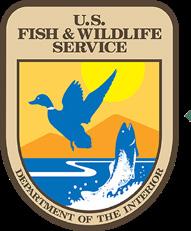

5900 Core Road, Suite 504 North Charleston, SC 29406 development@turtlesurvival.org 843.724.9763
turtlesurvival.org
reintroduced tortoise after replacing the GPS logger. Photo by Lance Paden.








 Photo: Radiated Tortoises are released into an expansive soft-release pen set into the habitat of a recipient site. Photo by Brett Bartek.
Photo: Radiated Tortoises are released into an expansive soft-release pen set into the habitat of a recipient site. Photo by Brett Bartek.
 Local women hired to collect cactus fruits to use as tortoise food at the Tortoise Conservation Center. Photo by Lance Paden.
Local women hired to collect cactus fruits to use as tortoise food at the Tortoise Conservation Center. Photo by Lance Paden.




